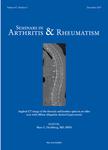版权所有:内蒙古大学图书馆 技术提供:维普资讯• 智图
内蒙古自治区呼和浩特市赛罕区大学西街235号 邮编: 010021

作者机构:L Scco Univ Hosp Rheumatol Unit Milan Italy Univ Genoa DIMI Chair Rheumatol Genoa Italy Univ Naples Federico II Chair Rheumatol Naples Italy Univ Pavia Chair Rheumatol I-27100 Pavia Italy IRCCS Policlin S Matteo Pavia Italy Ist Ric Farmacol Mario Negri Div Epidemiol Milan Italy Univ Siena Inst Rheumatol I-53100 Siena Italy
出 版 物:《SEMINARS IN ARTHRITIS AND RHEUMATISM》 (关节炎与风湿病论文集)
年 卷 期:2005年第35卷第1期
页 面:38-42页
核心收录:
学科分类:1002[医学-临床医学] 100210[医学-外科学(含:普外、骨外、泌尿外、胸心外、神外、整形、烧伤、野战外)] 10[医学]
主 题:osteoarthritis pain risk factors management guidelines
摘 要:OBJECTIVE The main objective of the AMICA project was to photograph the Italian scenario of osteoarthritis (OA) and its treatment in general and specialty practice. The study was designed to evaluate their prescription modalities to determine whether they matched the recently proposed treatment guidelines for OA (ACR 2000;EULAR 2000;APS 2002). METHODS The study involved 2764 general practitioners (GPs) and 316 specialists who enrolled a total of 25,589 patients with OA of the hand, knee, and hip. RESULTS Pharmacological treatment alone was prescribed to 55% of the patients seen by GPs, 25% of those seen by rheumatologists, 8% of those seen by orthopedic surgeons, and 17% of those seen by physical medicine specialists (GPs versus specialists, P 0.001). Specialists often prescribed a combined pharmacological and nonpharmacological approach (rheumatologists 51%, orthopedic surgeons 66%, physical medicine specialists 76%). Concomitant comorbidities and their treatment do not seem to influence OA prescription modalities except for peptic ulcer and anticoagulant therapy. The presence of peptic ulcer was associated with a reduction in NSAID prescriptions (OR 0.61, Cl 0.53 to 0.69) and more frequent use of Coxibs (OR 1.15, Cl 1.03 to 1.28) and simple analgesics (OR 1.42;Cl 1.26 to 1.61), as well as physical therapy. NSAIDs and Coxibs also were less frequently prescribed if patients were receiving anticoagulant therapy (NSAIDs OR 0.86, Cl 0.70 to 1.06;Coxibs: OR 0.77;Cl 0.64 to 0.93). Gastroprotective therapy was more frequently used in patients treated with NSAIDs, Coxibs, and analgesics. There was no significant difference in therapies prescribed for patients with hypertension or cardiac disease (myocardial infarction and/or angina pectoris). CONCLUSIONS The published guidelines appear to be properly used by most of the physicians in terms of the pharmacological approach;however, the increased use of Coxibs has not reduced the amount of prescribed gastroprotection. No sp